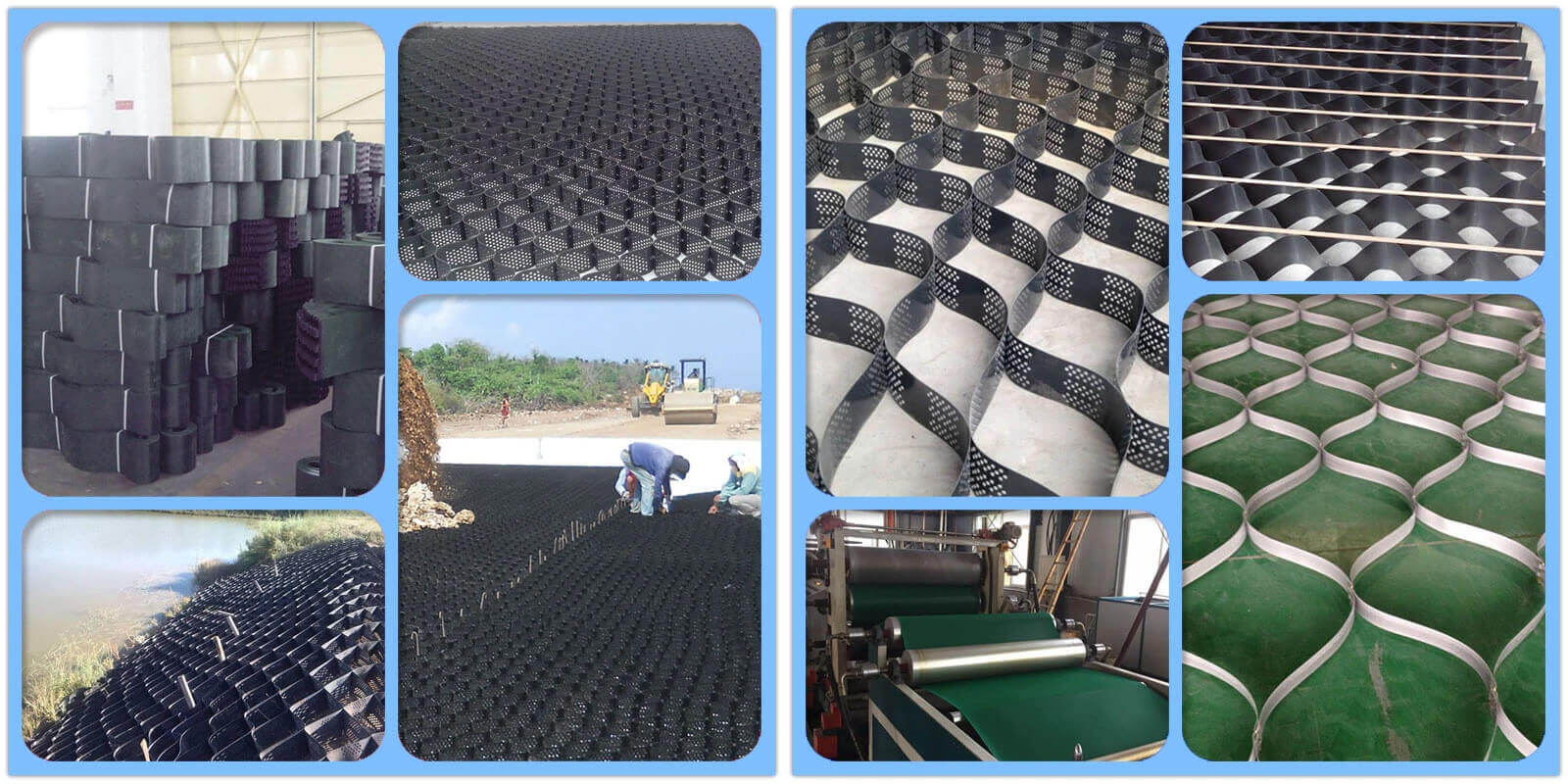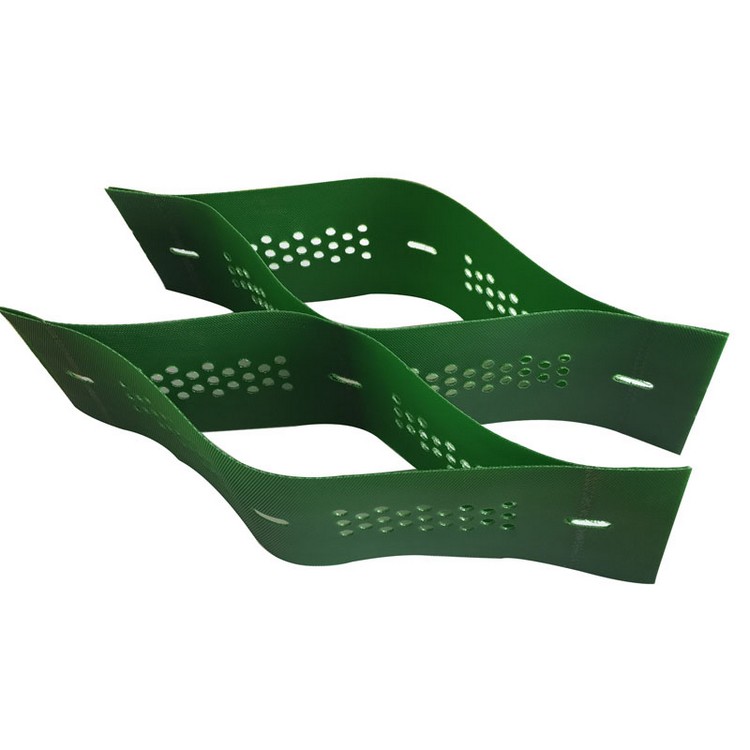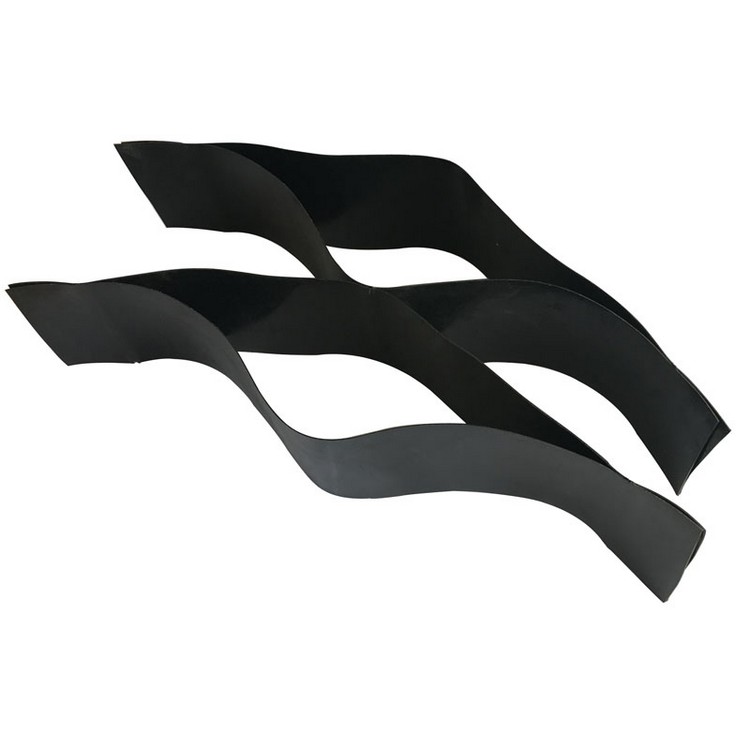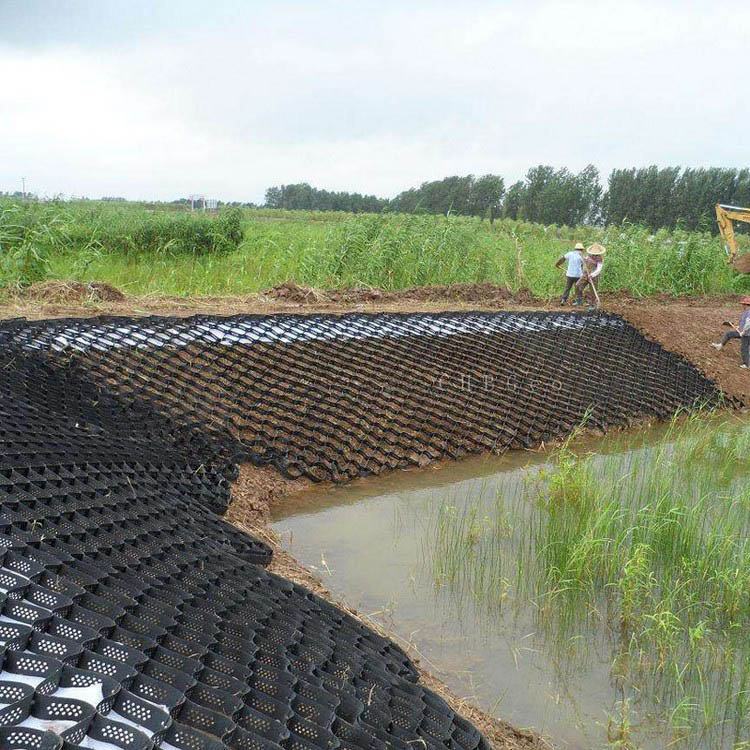Analysis of Force and Degeneration of Geocell Retaining Wall under Different Design Parameters
Abstract: The deformation and displacement laws of flexible retaining walls under different design parameters are studied by using finite difference software FLAC3D. The effects of retaining wall thickness, slope ratio and elastic modulus on deformation and displacement of retaining wall are calculated and analyzed. The results show that when the thickness is small, the horizontal earth pressure and wall displacement of the retaining wall are drum-shaped, the maximum value is near the wall height 1/2, and the horizontal displacement becomes smaller with the increase of the thickness; the slope is relatively small, the retaining wall level The earth pressure and wall displacement curves are similar, and the values are not much different. When the slope is relatively large, the horizontal earth pressure value and displacement value of the retaining wall increase to different degrees, and the displacement curve also becomes a straight line, reaching the top of the wall. Maximum; the horizontal earth pressure of the flexible retaining wall increases with the increase of the wall elastic modulus, and the horizontal displacement is just the opposite.
Keywords: plastic geocells for sale; flexible retaining wall; numerical analysis; design parameters; deformation law.
The plastic geocells manufacturers is a new type of geosynthetic material that appeared internationally in the early 1980s. It is light, wear-resistant, flexible, fast in construction and provides high lateral restraint. It is widely used in civil engineering. Because of its light structure, convenient construction and low cost, it can meet the requirements of green wall surface and has been widely used in highway slope protection. Some scholars have carried out related research on the new slope support structure of the plastic geocells factory price flexible retaining wall and achieved some results. Xie Yongli et al. used the finite element analysis software MARC to carry out elastoplastic numerical simulation analysis on the engineering behavior of the high quality plastic geocells flexible retaining wall. Song Fei et al. used PLAXIS software to study the effects of different aspect ratios, slopes and subgrade surface loads on the denaturing behavior of wholesale plastic geocells retaining walls. Ma Xinyan and other methods combined with numerical simulation and structural calculation, combined with the actual project, an example analysis of the flexible retaining wall of the road geogrid, and the construction process of the flexible retaining wall is summarized according to the construction experience. Wang Gen et al. used the ADINA finite element numerical simulation analysis to consider the coupling relationship between wall and subgrade soil and studied the mechanism of the multi-stage flexible retaining wall of plastic geocells for sale. Compare the stress of multi-level retaining walls under various working conditions. Yang Li et al analyzed the effect analysis of wholesale plastic geocells reinforced coarse-grained soil. Liu Jun and other engineering combined analysis of the sensitive factors of the wholesale plastic geocells flexible retaining wall. However, in the design process of plastic geocells for sale retaining wall, the stress and deformation law of high quality plastic geocells flexible retaining wall under different design parameters are still unclear. Therefore, the soil pressure calculation method lacks a reasonable theoretical basis, and theoretical research still lags behind engineering practice. Need to conduct in-depth research.
In this paper, the finite difference software FLAC3D of geotechnical engineering is used to calculate the stress and deformation characteristics of the geogrid flexible retaining wall under the design parameters. The effects of thickness, slope ratio and elastic modulus on the stress and deformation behavior of the flexible retaining wall are studied. It provides a theoretical basis for the calculation method of earth pressure of flexible retaining wall and has certain reference significance for engineering design.

1. Model establishment and related parameters
1.1 Model establishment
The numerical calculation model of the plastic geocells manufacturers flexible retaining wall includes a geometric model and material model. This paper needs to establish a flexible retaining wall calculation model according to the actual engineering problems and research purposes. The calculation model consists of three parts: the wall of the retaining wall, the foundation, and the back of the wall. After consulting reference and trial calculation, the model dimensions of each part are determined as follows: the length of the retaining wall is 15m, the height is 6m, the thickness is 3m, the design gradient of the retaining wall is 1:0.5, the base width is 4m, and the thickness is 1m. The width of the soil behind the wall is 15m. The three-dimensional solid geometric model and the boundary diagram are shown in Figure 1 and Figure 2, respectively. Since the model is analyzed using a portion of the overall retaining wall, the boundary conditions of the retaining wall model need to be determined. The X-direction displacement constraint of the front and rear facades of the retaining wall is zero, and the Z-direction displacement constraint is zero in the front and rear boundary of the retaining wall. The bottom boundary of the flexible retaining wall is in the X, Y and Z directions. The applied displacement constraint is zero.
1.2 Meshing
In the process of numerical analysis of FLAC3D, the more the unit division, the finer the calculation result, but the excessive division of the unit will increase the computational burden, resulting in a slow calculation process. Considering various factors comprehensively, the grid division of this calculation unit adopts “sweeping grid division”, and the wall of the retaining wall is taken as the key research object to perform grid encryption processing; the basic part and the soil part are used as a non-research focus. The division of the grid is relatively sparse. The specific unit mesh is divided as shown in Figure 3. The entire model has a total of 17,904 nodes and 15,585 units.
1.3 Selection of model parameters
In the geogrid flexible retaining wall, the Mohr-Coulomb ideal elastoplastic model of the soil constitutive model is relatively complete, simple and practical, and is widely used in geotechnical engineering and theoretical practice. The Mohr-Coulomb ideal elastoplastic model in FLAC3D numerical analysis software requires input of five parameters, namely cohesion c, internal friction angle φ, density ρ, shear modulus G and bulk modulus K. The cohesion c, the internal friction angle φ, and the density ρ can be obtained by routine experiment of the soil sample, and the shear modulus G and the bulk modulus K can be obtained according to the elastic modulus E and the Poisson’s ratio μ, and the calculation method thereof As shown in formula (1).
1.4 Contact surface optimization
In this paper, the structural planes connected to the retaining wall, the foundation and the backfill of the wall are treated by contact surface form, which is stimulated by the Interface contact unit provided in FLAC3D software. The interface contact unit has a thickness of zero but is directional, which is represented by assigning a triangular area unit to each node. When the contact surface unit is set, the interface unit is required to be tiled to a predetermined target surface and contacted with the other. The faces are connected together. When the tangential force on the contact surface is less than the maximum tangential force, it is in the elastic phase. The normal force and the tangential force at a certain moment can be determined by the formulas (2) and (3).
When |Fs|=Fsmax, when the contact surface slides, the tangential force remains unchanged and enters the plastic deformation stage. The normal stress increases with the increase of displacement, which can be calculated according to formula (4).

2. Project instance calculation
2.1 Initial stress balance
Before the construction of the plastic geocells manufacturers flexible retaining wall, the ground displacement of the construction site is zero, but the stress in the soil is always present. This state of no stress is only the state of stress existence, that is, the equilibrium state of the ground stress. In the numerical simulation process, the initial stress balance is to obtain a state in which the numerical model obtains initial stress but the initial strain is zero. Considering that the self-weight stress is the main initial stress in the construction site of the flexible retaining wall, it is obvious that the self-weight stress is the external force. The ground stress field extracts the internal force of the site under the self-heavy stress and applies it to the numerical model. When the numerical calculation is started, the self-weight stress is applied. The internal force and the external force in the field are balanced to obtain a more accurate initial state of the numerical model without interference from human factors. The horizontal effective stress and horizontal displacement of the slope body under self-weight stress are shown in Fig. 4 and Fig. 5.
2.2 Horizontal soil pressure and deformation comparison analysis
Based on the results of the previous analysis, the numerical simulation results are compared with the field test and the model test. The numerical simulation results and comparison curves of earth pressure are shown in Fig. 6 and Fig. 7. The horizontal displacement numerical simulation and curve are shown in Figure 8 and Figure 9.
It can be seen from Fig. 7 that there is a certain gap between the numerical calculation result of the horizontal earth pressure of the flexible retaining wall and the measured value of the field, and the numerical calculation result is smaller than the actual one. The numerical calculation calculates the maximum earth pressure value of 55.32 kPa, which is located at the height of the retaining wall of 2.5 m. The actual measured earth pressure value is 57.62 kPa, and it is located at 1/2H of the wall height (the height of the retaining wall is 3 m). This is mainly due to the fact that the numerical analysis establishes the calculation model and sets the boundary conditions under ideal conditions, and cannot completely accurately simulate the influence of the retaining wall and the construction machinery. Therefore, there are certain differences in the actual measurement on-site, and the actual measurement on-site is not only susceptible to the surrounding environment. There will also be some unavoidable human error.
It can be seen from Fig. 9 that the numerical simulation results of the horizontal displacement of the flexible retaining wall are basically consistent with the field test and the model test, all of which are bounded by the wall height 1/2H, and the horizontal displacement above the boundary decreases with the wall height, and the boundary The following increases along the wall height. The numerical simulation shows that the maximum wall displacement is 4.52 cm, which is 15.04% smaller than the field test result and 2.03% larger than the model test. It shows that the numerical simulation results in this paper are not much different from the field test and model test results, and the curve development trend is basically similar. Therefore, it can be considered that the numerical analysis in this paper is closer to reality in terms of horizontal displacement of the wall.

3. Impact analysis of flexible retaining wall design parameters
According to the previous analysis, it is important to understand the influence of the design parameters of each retaining wall on the stress and deformation of the plastic geocells factory price flexible retaining wall, which is of great significance for the design and construction of the retaining wall. In this paper, three parameters of retaining wall thickness, retaining wall slope ratio and retaining wall elastic modulus are selected to analyze the three working conditions, as shown in Table 2. In order to grasp the influence of such parameters on the force and deformation of the retaining wall, the design of the retaining wall is optimized, and the basis for calculating the earth pressure of the retaining wall is provided.
3.1 Influence analysis of the thickness of retaining wall
Figure 10 shows the horizontal stress and displacement of the wall back when the wall thickness is 6m and the slope ratio is 1:0.5. The wall thickness varies from 2m to 5m.
It can be seen from Fig. 10(a) that the height distribution of the earth pressure along the retaining wall is different when the thickness of the wall of the flexible retaining wall with a height of 6 m is different. When the wall thickness is 2m, the horizontal earth pressure of the retaining wall is small overall, but at the wall height of 3m, the earth pressure increases sharply, reaching 69.73kPa; when the wall thickness is 3m, the earth pressure distribution is relatively uniform. The height of the wall reaches the maximum at 2.5m, and the maximum is 55.32kPa. When the thickness of the wall is 4m and 5m, the horizontal earth pressure values of the retaining wall are not much different, and they all have an irregular linear distribution, and gradually change with the height of the retaining wall. Big.
It can be seen from Fig. 10(b) that the horizontal displacement curve of the wall back and the earth pressure curve has certain similarities under different retaining wall thicknesses. When the wall thickness is 2m, the retaining wall is deformed greatly, especially at the wall height of 3m, reaching 6.34cm, and the deformation is greater than 3% of the retaining wall thickness, indicating that the thickness of the retaining wall of 2m can not meet the safety design requirements of the retaining wall. When the wall thickness is 3m, 4m, and 5m, the horizontal displacement of the retaining wall is not much different. This also shows that on the basis of meeting the safety design requirements of the retaining wall, blindly increasing the thickness of the retaining wall has limited control on the deformation of the retaining wall, but only Increase project cost.
3.2 Influence analysis of slope ratio of retaining wall
Fig. 11 is a geogrid flexible retaining wall with a wall height of 6 m and a wall thickness of 3 m. The earth pressure and horizontal displacement curve of the wall under the condition of changing the slope ratio of the retaining wall.
It can be seen from Fig. 11(a) that the steeper the slope of the flexible retaining wall, the greater the horizontal earth pressure of the retaining wall. When the slope of the retaining wall is 1:0.75 and 1:0.50, the horizontal earth pressure distribution curve of the retaining wall is similar, and the boundary is 2.5m at the wall height. Above the boundary, the earth pressure decreases linearly along the wall, and the lower part of the boundary is just the opposite. The soil pressure at the demarcation point is the largest, respectively 55.32 kPa and 49.96 kPa; when the slope of the flexible retaining wall is 1:0.25, the earth pressure is linearly distributed along with the wall height, reaching a maximum of 60.11 kPa at the bottom of the retaining wall.
It can be seen from Fig. 11(a) and Fig. 11(b) that when the slope ratio of the retaining wall is between 1:0.75 and 1:0.50, the slope ratio has little effect on the horizontal earth pressure and wall displacement of the retaining wall. During the design of the retaining wall, the slope of the retaining wall can be appropriately increased between 1:0.75 and 1:0.50, thereby reducing the footprint of the retaining wall; however, if the slope ratio of the retaining wall is greater than 1:0.50, it is necessary to continue It is necessary to increase the slope of the retaining wall to reduce the floor space, because the horizontal displacement of the flexible retaining wall with a slope ratio of 1:0.25 is large, and the height of the retaining wall increases linearly, and the maximum displacement point reaches 5.57cm. It shows that when the design of the flexible retaining wall is steep, the force form and displacement deformation law have changed greatly. During the construction process and after the construction is completed, the retaining wall may also have a displacement around the top of the wall.
3.3 Influence analysis of elastic modulus of retaining wall
Figure 12 shows the effect of wall elastic modulus on horizontal earth pressure and wall displacement of plastic geocells factory price flexible retaining wall with a wall height of 6m, slope ratio of 1:0.50 and retaining wall thickness of 3m. The modulus in the figure refers to the wall elastic modulus, and the value ranges from 5×106 Pa to 5×10 10 Pa.
It can be seen from Fig. 12(a) that the horizontal earth pressure of the retaining wall increases as the elastic modulus of the retaining wall increases. When the wall elastic modulus is between 5×106Pa and 5×108Pa, the horizontal earth pressure of the retaining wall is approximately drum-shaped, but the position of the retaining wall with the maximum earth pressure value is different, and the wall elastic modulus is 5×106Pa and 5. When ×107Pa, the maximum earth pressure value is located at 2.5m height of the wall, which is 43.21kPa and 55.32kPa respectively. When the wall elastic modulus is 5×108Pa, the maximum earth pressure is 61.32kPa at the wall height of 3m. When the wall elastic modulus is 5×109Pa and 5×1010Pa, the wall material is closer to the rigid material, and the earth pressure curve of the retaining wall is similar to that of the rigid retaining wall. The soil pressure value is the highest near the wall height 1/3H, respectively. 71.19 kPa and 84.76 kPa.
It can be seen from Fig. 12(b) that the horizontal displacement of the flexible retaining wall decreases as the elastic modulus of the retaining wall increases. The wall elastic modulus is between 5×105Pa and 5×107Pa, and the wall displacement of the retaining wall is drum-shaped. The maximum displacement point is 9.21cm in the middle of the retaining wall, which is 3.07% of the thickness of the retaining wall, which does not meet the design safety requirements. , indicating that the elastic modulus of the retaining wall material is too low, which will cause large deformation of the retaining wall. Therefore, the material of the retaining wall must be inspected and accepted before construction; the elastic modulus of the wall is 5×106Pa~5×107Pa. During the interval, the horizontal displacement law of the retaining wall is basically the same, showing an obvious nonlinear distribution, reaching the maximum at the height of 1/2H. When the wall elastic modulus is greater than 5×108Pa, the horizontal displacement curve of the retaining wall is very large. The change increases linearly with the height of the retaining wall and reaches its maximum position at the top of the wall.

4. Conclusion
In this paper, the FLAC3D software is used to simulate the geogrid flexible retaining wall. The influence of different design parameters on the force and deformation of the 6m high shoulder-type high quality plastic geocells flexible retaining wall is analyzed. The following conclusions are drawn:
(1) When the thickness of the 6m high flexible retaining wall is 2m~3m, the horizontal earth pressure and wall displacement of the retaining wall are drum-shaped, and the maximum is located near the wall height 1/2H; when the wall thickness is greater than 3m The horizontal displacement of the wall becomes smaller, and the earth pressure and displacement curve of the back of the wall gradually transition to a linear model.
(2) The flexible earth retaining wall with two slope ratios of 1:0.50 and 1:0.75 has similar horizontal soil pressure and wall displacement curves, and the values are not much different, and both are bounded by 1/2H wall height; when the flexible retaining wall When the slope ratio is 1:0.25, the horizontal earth pressure value and displacement value of the retaining wall have increased to different degrees, and the displacement curve also becomes a straight line, reaching the maximum at the top of the wall, which is 5.57cm.
(3) The horizontal earth pressure of the 6m high flexible retaining wall increases with the increase of the wall elastic modulus, and the horizontal displacement is opposite, which decreases with the increase of the wall elastic modulus. When the bulk modulus is between 5×106Pa and 5×108Pa, the earth pressure of the retaining wall and the horizontal displacement of the wall are drum-shaped, reaching the maximum at the height of 1/2H; when the wall modulus is 5 When the distance between ×109Pa and 5×1010Pa, the horizontal earth pressure and displacement curve change significantly, the displacement curve is roughly linear, and the earth pressure also becomes similar to that of the rigid retaining wall, reaching the maximum at 1/3H of the wall height.
